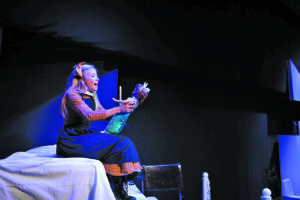 Originally built by William Harvey in 1845 and then valued at $665, the Cherry Hill Farmhouse on Park Avenue went through the Civil War and a handful of homeowners until it was turned over to the City of Falls Church government in 1968, and into a museum eight years later.
Originally built by William Harvey in 1845 and then valued at $665, the Cherry Hill Farmhouse on Park Avenue went through the Civil War and a handful of homeowners until it was turned over to the City of Falls Church government in 1968, and into a museum eight years later.
Tax assessments show that a slave was held on the property in 1845, during which Harvey owned the home. He went bankrupt shortly thereafter and sold the property to George Steele for $1,950 in 1848.
“When Harvey filed for bankruptcy, he had to mortgage his possessions, including woodworking tools so we know he did the woodwork himself,” said Cherry Hill Farm Coordinator Diane Morse, who noted many of the dining room cabinets were built into the home’s structure.
Steele then sold it for $4,000 to William Blaisdell in 1856. Nine years later, Blaisdell put it on the market and it wasn’t long before William Sheppard snatched it up for $7,000 in 1865. But Sheppard, merely an investor, never actually lived in the home. Next in line to buy were Joseph and Mary Edwards Riley, whose daughter, Mary Riley Styles should ring a bell to local bookworms. Back in 1870, the Riley family paid Sheppard $5,000, though an 1869 sales flier listed the home for sale at $12,000.
“Sheppard was in debt, needed money and for some reason,” said Morse.
The Rileys had four daughters and one son, Harvey, who inherited the house and gave it to the University of Virginia. The City bought the property in 1956, but wasn’t able to do much with it at that time.
“Falls Church City purchased the property under a life tenure clause that stipulated the home could be occupied as a residence as long as any remaining Riley was alive. The last Riley sister passed in 1968,” said Morse.
In 1845, the land was worth about $5 an acre for timbered land and $10 an acre for cleared land in the 1840s. The structure sits on 73 acres of land and Morse estimated its current value somewhere in the ballpark of $600,000 or more.
“The market during 40s and 50s was highly speculative and people were flipping real estate,” said Morse. The home didn’t have electricity or indoor plumbing until 1920, the same year when the original kitchen was gutted and refurbished. Its location off the back of the house was common during the 1800s, when the danger of kitchen fires was very real.
The home didn’t have electricity or indoor plumbing until 1920, the same year when the original kitchen was gutted and refurbished. Its location off the back of the house was common during the 1800s, when the danger of kitchen fires was very real.
“If the housewife was doing her own cooking, she wanted the convenience of an attached kitchen,” said Morse.
Non-profit organization, Friends of Cherry Hill Foundation, is responsible for the mid-19th-century furnishings inside the Farmhouse. It’s open to the public Mon. – Thurs. between 10 a.m. – 3 p.m. and Sat. (April – Oct. only) between 10 a.m. – 1p.m. Group tours can be arranged by appointment. For more information, call 703-248-5171.
{gallery}/852/cherryhill{/gallery}
(Photos: Peter Flint)










